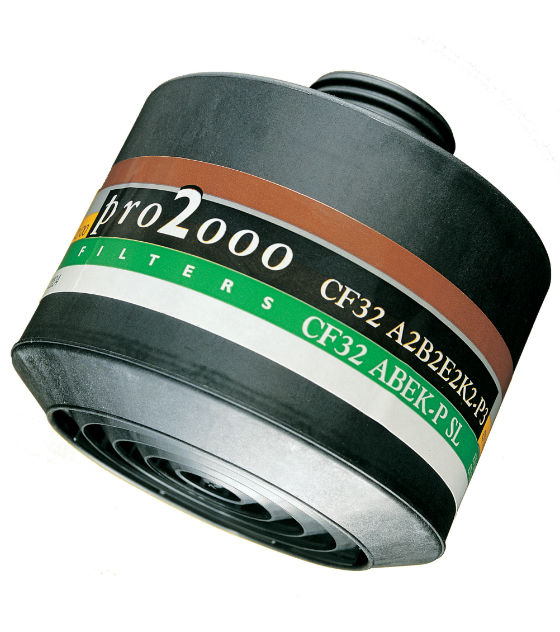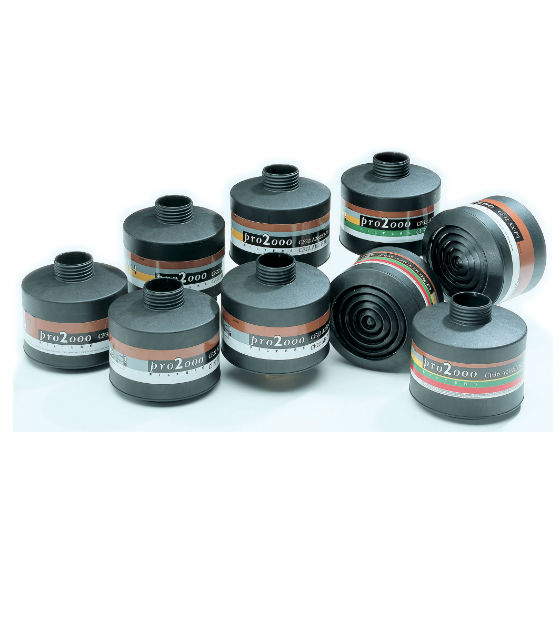3M Scott Safety PRO2000 Filters
The 3M Scott Safety Pro2000 Filters range offers a wide choice of filters for specific respiratory challenges, providing high quality and cost efficient protection.
Key Features
- Particle filters trap solid and liquid particles, e.g. dusts, smoke, welding fumes, mists, micro-organisms and radioactive particles
- Gas filters protect against hazardous gases and vapours
- Combined filters protect against both gaseous and particulate contaminants
The Scott Pro2000 canister filter range offers a wide choice of filters for specific respiratory challenges, providing high quality and cost efficient protection. Highest specification filter media and materials ensure durability and reliability in the most demanding applications.
Combining low weight and low breathing resistance, Scott Pro2000 filters are manufactured using superior performance media, giving extended adsorption capacity for gas and combined filters and unrivalled efficiency for the particle element.
Pro2000 filters are fully EN approved to the latest standards, marked 'R' for re-usable (EN 143:2000/ A1:2006), CE certified, and connect via a 40 mm EN148-1 thread. CE approvals: EN143, EN14387. CE0121.
Pro2000 Filters
- • Particle filters trap solid and liquid particles, e.g. dusts, smoke, welding fumes, mists, microorganisms and radioactive particles
- • Gas filters protect against hazardous gases and vapours
- • Combined filters protect against both gaseous and particulate contaminants
Particle Filters
- • Scott particle filters use only microfibre 'paper' media and do not use any electrostatic filtering method. They are marked 'R' for "reusable" (EN 143/A1:2006)
- • PF10 P3 features a high capacity filter element; it removes even the smallest particles with efficiency better than 99,99 %
- • The filter element is extremely waterrepellent (hydrophobic)
Gas Filters
- • Use the highest grade active carbon materials, additionally treated for best performance
- • With a safe margin to EN requirements, Pro2000 gas filters perform effectively using only 220-320 ml of carbon
- • Less carbon provides low weight and less resistance - real benefits for the user
Combined Filters
- • Combined filters remove hazardous gases and vapours as well as solid and liquid particles
- • The particle filter removes aerosolbased particles such as paint droplets. When spraying liquid substances (e.g. spraypainting) a combined filter should be used.
How To Select A Filter
- • Will the atmosphere contain sufficient oxygen throughout the period of exposure?
- • Which hazardous substances are likely to be present? What are their physical and chemical properties?
- • Which forms do the airborne contaminants take - dust, fibre, mist, fume, microorganism, gas, vapour, radioactive particulates or gases?
- • What health effects can these substances have on the body? Special attention is needed if there are several substances that may interact, either by reacting chemically, or by having synergistic adverse health effects.
- • What are the concentrations in the atmosphere?
- • What are the relevant occupational exposure limit values or the safe exposure levels?
A filtering device should have the correct type of filter matched to the substance(s) from which the wearer needs protection. The maximum mass of filter designated to be connected to a half mask is 300g and to a full face mask 500g. Filters are colour coded, marked with type and class, as well as labelled with the shelf life as factory sealed. The filter label includes the "CE" mark and EN standard number(s), and markings relevant to particular types; if for a powered respirator, the device class.
- To order contact us via:
Phone: Call +44 (0)330 088 0560 - Email: [email protected]
- Web Form: Get Pricing
| PRO 2000 |
|
|---|







